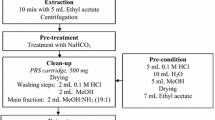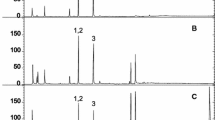Abstract
Since literature reports suggest βN-alkanoyl-5-hydroxytryptamides to account for stomach irritations perceived by sensitive subjects after coffee consumption, there is increasing interest in the concentrations of these substances in coffee and coffee products. A versatile analytical method for the accurate quantitative analysis of βN-alkanoyl-5-hydroxytryptamides in coffee by means of reversed-phase high-performance liquid chromatography with fluorescence detection and synthetic βN-heptadecanoyl-5-hydroxytryptamide as the internal standard was developed. Spiking coffee samples with known amounts of βN-alkanoyl-5-hydroxytryptamides followed by quantitative analysis revealed recovery rates of 99–103%. On the basis of the results of liquid chromatography–mass spectometry/mass spectometry experiments as well as co-chromatography with the synthetic reference compounds, the previously unknown βN-heneicosanoyl-5-hydroxytryptamide and βN-tricosanoyl-5-hydroxytryptamide were detected for the first time in coffee.




Similar content being viewed by others
References
Harland BF (2000) Nutrition 16:522–526
Parliment TH, Ho CT, Schieberle P (2000) Caffeinated beverages—health benefits, physiological effects, and chemistry. Culinary and Hospitality Industry Publications Services, Weimar, TX
Battini ML, Careri M, Casoli A, Mangia A, Lugari MT (1989) Ann Chim 79(7–8):369–377
Nebsny E, Budryn G (2002) Nahrung/Food 46(4):279–282
Van der Stegen GHD, Noomen PJ (1977) Lebensm Wiss Technol 10:321–323
Wurziger J (1971) In: Proceedings of the 5th ASIC colloquium (Lisbon), ASIC, Paris, France, pp 383–387
Culmsee O (1975) Deutsche Lebensmittel Rundschau 71(12):425–427
Wurziger J, Harms U (1968) Z Lebensm Unters Forsch 138(2):75–80
Folstar P, Schols HA, van der Plas HC, Landheer AL, van Veldhuizen A (1980) J Agric Food Chem 28:872–874
Hunziker HR, Miserez A (1977) Mitt Gebiete Lebensm Hyg 68:267–274
Bürgin E (1975) Ger Office patent DE-74-2429233 19740618
Rösner P, Keiner F, Kühn U (1971) Med Klein 66:238–242
Hunziker HR, Miserez A (1979) Mitt Gebiete Lebensm Hyg 70:142–152
Kummer P, Bürgin E (1976) Mitt Gebiete Lebensm Hyg 67:212–225
Lagana A, Curini L, De Angelis Curtis S, Marino A (1989) Chromatographia 28(11–12):593–596
Organikum (1986), 16. Auflage, VEB deutscher Verlag der Wissenschaften, Berlin 1986
Acknowledgements
This research project was supported by a grant from the Forschungskreis der Ernährungsindustrie e.V., Bonn, Germany, the Arbeitsgemeinschaft industrieller Forschung, and the German Ministry of Economics (project no. 14042 N).
Author information
Authors and Affiliations
Corresponding author
Rights and permissions
About this article
Cite this article
Lang, R., Hofmann, T. A versatile method for the quantitative determination of βN-alkanoyl-5-hydroxytryptamides in roasted coffee. Eur Food Res Technol 220, 638–643 (2005). https://doi.org/10.1007/s00217-004-1123-y
Received:
Published:
Issue Date:
DOI: https://doi.org/10.1007/s00217-004-1123-y




